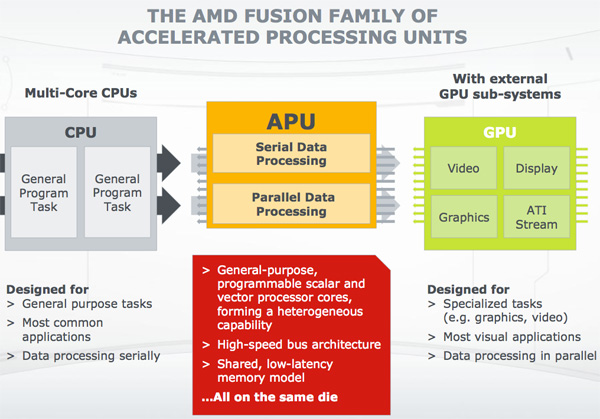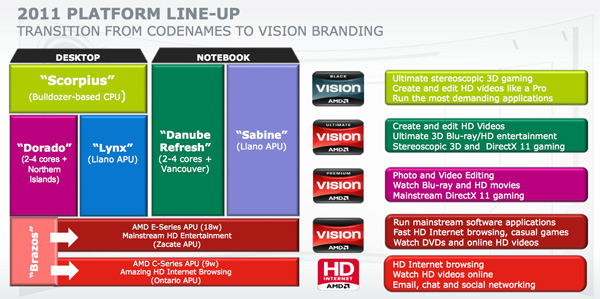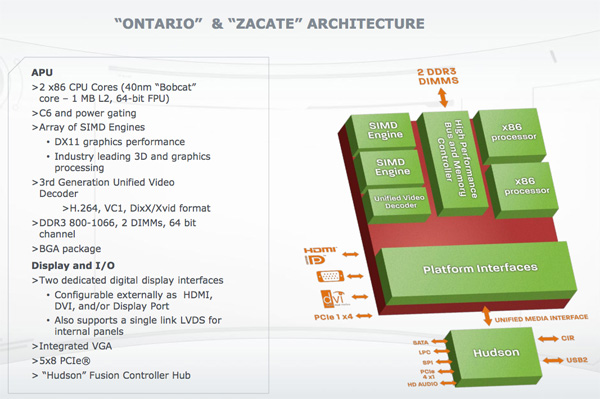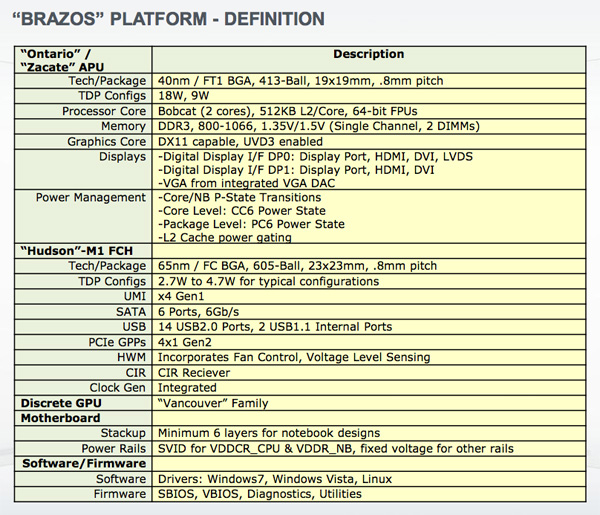Previewing AMD's Brazos, Part 1: More Details on Zacate/Ontario and Fusion
by Anand Lal Shimpi on November 9, 2010 1:09 AM ESTMeet the Brazos
The platform is called Brazos. Brazos encompasses two chips: a Zacate or Ontario APU (Accelerated Processing Unit) and the Hudson Fusion Controller Hub (FCH). This is the whole reason AMD bought ATI, Zacate and Ontario are its first CPU-GPU hybrids.
While AMD is primarily targeting the netbook/ultraportable and notebook markets with Ontario and Zacate (respectively), we’ll also see nettops/desktops and mini-ITX motherboards based on Brazos. This may be the first time we see real competition to NVIDIA’s ION platform.

AMD's Zacate APU, 19mm x 19mm package, 413 balls, 75mm^2 die
Both APUs are built from the same die. Zacate and Ontario are physically identical, they just run at different clock speeds. The 40nm die is manufactured at TSMC and measures 75mm^2. The chip is very cheap to package as well. The BGA package only has 413 balls. As one AMDer put it, these chips are designed to be stamped out as quickly and as cheaply as possible.
Both are available in single and dual core versions, although the single core variant is just a dual-core chip with one core disabled to hit various market segments. Core unlocking is apparently possible, but unexpected given the target for these platforms and the amount of effort OEMs would have to go to in order to enable it.
The CPU cores are based on AMD’s first truly low power client architecture, codenamed Bobcat. We’ve discussed Bobcat in great length already, but at a high level it looks a lot like an out-of-order Atom processor without Hyper Threading. The fundamental architecture advantage should give Bobcat the performance advantage over Atom, at least at identical clock speeds.
The GPU is based on AMD’s 5000 series architecture (Evergreen) and features 80 shader cores and AMD’s new UVD3 decode engine.
The SKUs
At launch you’ll see four SKUs, the combinations and specs are listed below:
| AMD Brazos Lineup | ||||||||
| APU Model | Number of Bobcat Cores | CPU Clock Speed | GPU | Number of GPU Cores | GPU Clock Speed | TDP | ||
| AMD E-350 | 2 | 1.6GHz | Radeon HD 6310 | 80 | 500MHz | 18W | ||
| AMD E-240 | 1 | 1.5GHz | Radeon HD 6310 | 80 | 500MHz | 18W | ||
| AMD C-50 | 2 | 1.0GHz | Radeon HD 6250 | 80 | 280MHz | 9W | ||
| AMD C-30 | 1 | 1.2GHz | Radeon HD 6250 | 80 | 280MHz | 9W | ||
Zacate takes the top two SKUs, while Ontario makes up the bottom two. The difference in TDP is entirely based on the clock speed of the CPU and GPU. And here is my concern. While a pair of Bobcats running at 1.6GHz are just awesome, drop the clock to 1.0GHz and I start getting concerned about performance. AMD didn’t let us test the C-50 but I’m curious to see what the margin of victory will be over Atom at that speed.
The GPU runs at 500MHz at the high end (Radeon HD 6310) and 280MHz at the low end (Radeon HD 6250). This paired with the single channel DDR3-800/1066 memory bus that has to be shared with the Bobcat cores means you should expect sub-5450 levels of performance out of these systems. Given their price point, that’s potentially not too bad. More enticing however is the fact that these APUs gain the benefit of the driver work AMD does on its discrete cards. Finally, game compatibility should be just as good on the low end as it is on the high end - assuming you meet the minimum specs for the title you’re running.
The lack of a brand for the CPU is a bit puzzling, but graphics are where it’s at these days.














106 Comments
View All Comments
flyck - Tuesday, November 9, 2010 - link
Don't forget the chip is manufactured on 40nm. I believe ontario platform released will be ok for the current market. The GF 28nm node for the next models will be the thing that will make ontario succeed or fail.Dark_Archonis - Tuesday, November 9, 2010 - link
By the time the next models on 28mm come out, Atom will be redesigned for out-of-order execution, and ultra low voltage Ivy Bridge models will likely be on sale at the low-end.mino - Tuesday, November 9, 2010 - link
Cheap Ivy Bridge, powerful yet low power Intel IGP, ... Atom faster that Bobcat ...I do not know what you are smoking, but it must be good.
There will be no cheap low power IB. Well, not before 2013.
Ontario #2 is here Q1 2012. How about that.
/end troll reply
Dark_Archonis - Tuesday, November 9, 2010 - link
Ontario #2 will be here Q1 2012? Really? Is that the one on the 28nm process? Somehow I doubt that AMD will release it at that time.Point is, I wouldn't be so sure of Bobcat being a huge success. Let's wait and see what happens shall we?
mino - Tuesday, November 9, 2010 - link
Yes, the 28nm one.Bobcat is the right design for the right market at the right time (even pulled in quarter!) for a great price.
There is possibly no way for it to not succeed. The question remains, how much.
Dark_Archonis - Tuesday, November 9, 2010 - link
Low-end laptops mostly use Celerons and Pentiums. I don't see Bobcat changing that situation much.Bobcat could do well with netbooks, except there is a problem. Netbook market share is declining, mainly due to the iPad.
So in reality, Bobcat has to compete not just with Intel, but also with Apple.
The only other viable market might be the HTPC market. That is not a very big market though, and Intel is pushing hard in that market as of now.
sprockkets - Tuesday, November 9, 2010 - link
Why? The whole point of atom is ultra low power usage in devices like phones where ARM dominates.Never going to happen.
Kiijibari - Tuesday, November 9, 2010 - link
You forget the fundamentally difference between Atom and Bobcat:Bobcat is a OoO CPU, Atom is a InOrder CPU.
Therefore Bobcat will have a much higher performance per clock. If 500 Mhz clock advantage is enough for Atom to beat Bobcat has to be seen.
You might compare that to the i5-760 vs. Phenom2 955/965 situation. Even though the Phenoms run at higher clocks, they are not faster as the lower clocked i5. That's because the i5 has a higher IPC, too. In that case not because of OoO <> InO, but that doesn't matter for the comparison.
mino - Tuesday, November 9, 2010 - link
Actually we have a wery good comparison available right on the market. It is even hinted in the article.Just take 1,3GHz CULV C2D, pair it with a lower clocked 5450 and we are in the ballpark of 18W ontario give or take 10%.
Now we just need to remember where Atom stands relative to C2D ...
Dark_Archonis - Tuesday, November 9, 2010 - link
Atom will improve, Intel won't be sitting still.